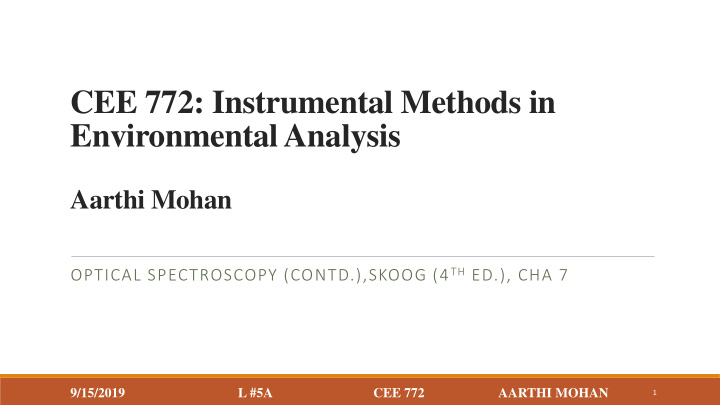



CEE 772: Instrumental Methods in Environmental Analysis Aarthi Mohan OPTICAL SPECTROSCOPY (CONTD.),SKOOG (4 TH ED.), CHA 7 9/15/2019 L #5A CEE 772 AARTHI MOHAN 1
Example of a Simple Spectrophotometer Spectronic 20 340-950 nm (visible range) Single beam Spectral bandpass 20 nm Quantitative at single wavalengths 2 9/15/2019 L #5A CEE 772 AARTHI MOHAN
Single Beam Spectrophotometer Sample holder Amplifier Photoelectric and readout Wavelength selector detector Sample Double Beam Spectrophotometer Amplifier and readout Photoelectric Wavelength selector detector D2 or Tungsten lamp Reference 9/15/2019 L #5A CEE 772 AARTHI MOHAN 3
Shimadzu Agilent 8453 (~2008) Shimadzu UV 1900 UV- deuterium UV/ Vis- 190-1100 nm Thermo Fisher, Genesys 10s Vis- Tungstan filament lamp UV-Vis Double beam 1nm bandwidth 4 9/15/2019 L #5A CEE 772 AARTHI MOHAN 9/15/2019
Cary 100 UV-Vis Spectrophotometer 0.2 nm bandwidth Single, Double or Dual-Single Beam Modes https://www.agilent.com/en/products/uv-vis-uv-vis-nir/uv-vis-uv-vis-nir- systems/cary-100-uv-vis 9/15/2019 L #5A CEE 772 AARTHI MOHAN 5
Single - beam Dual - beam Advantages -less expensive -Modern improvements permit high level of automation and offer the -High energy throughput same or even better level of detection as compared to earlier single (no source splitting, hence beam systems. better sensitivity) -Instability factors due to lamp drift, stray light, voltage fluctuations do not affect the measurement in real-time. -Little or no lamp warm up time is required. -Improved results and lamp life Old dual beam instruments re complicated, Disadvantages Instability (no corrections difficult to align, and expensive to service. for disturbances like circuit fluctuations, voltage fluctuations, mechanical component’s instability or drift in energy of light sources) 9/15/2019 L #5A CEE 772 AARTHI MOHAN 6
Optodes (Harris, 7 th ed., pg. 437; Skoog, 4 th ed., pg. 108) Refraction- Snell’s Law Angle of incidence=angle of reflection n 1 sin ϴ = n 2 sin ϴ Chemical sensor based on optical fiber construction Constructed by placing a chemically sensitive layer at the end of the fibre (photosensor) E.g. Sulfites in food, nitric oxide in cells, explosives in GW. 7 9/15/2019 L #5A CEE 772 AARTHI MOHAN
Considerations for selecting a spectrophotometer Detection limits Nature of analyte you wish to measure Wavelength range Analytical working range Sample throughput (single sample vs. multi-sample) Data quality Cost (and footprint) of instrument and associated consumables Customizable and/or pre-configured method options Measurement time https://www.coleparmer.com/tech-article/spectroscopy-selection-guide 9/15/2019 L #5A CEE 772 AARTHI MOHAN 8
Errors and deviations in linearity Deviations Real Instrumental Chemical -As position of equilibrium changes, -Beer Lambert only applies to -Polychromatic radiation concentration of absorber changes. dilute solutions (mM) (A vs C -Stray light -Equilibrium can be affected by linear) -Bandpass association/dissociation/complexation. At high concentrations, ϵ not -Corrected by using isobestic point at constant- deviation from law- which absorbance of all equilibria components are similar. 9/15/2019 L #5A CEE 772 AARTHI MOHAN 9
Errors and deviations in linearity -Instrumental (polychromatic) -due to band pass of measurement -narrow slit and wide bandpass gives changing ϵ 10 9/15/2019 L #5A CEE 772 AARTHI MOHAN
Errors and deviations in linearity Skoog, 4 th ed., Fig -Instrumental (stray light) 7-8 -Increased light reaching detector -Occurs when I<<Io -Negative error or deviation -Improved by decreasing bandpass Thomas & Burgess, 2007 11 9/15/2019 L #5A CEE 772 AARTHI MOHAN
Errors and deviations in linearity -Instrumental (slit width) -Narrower the slit width, better resolved the spectra. -Loss of details dur to wider slit width shown in figures. DIDYMIUM GLASS (safety glass material) 12 9/15/2019 L #5A CEE 772 AARTHI MOHAN
Errors and deviations in linearity -Instrumental (Stray light) -Spectra of cerium (IV) obtained in a glass optics (A) and quartz optics (B) cell. -Note false peak at A This occurs due to transmission of stay at longer wavelengths. (Skoog, 4 th ed., Fig 7-12) 13 9/15/2019 L #5A CEE 772 AARTHI MOHAN
Accuracy is dependant on the instrument! 14 9/15/2019 L #5A CEE 772 AARTHI MOHAN
Errors impacting precision (Ref Table 7-3, Sec 7B-4,Skoog, 4 th ed.) Limited readout resolution Dark current Amplifier noise S c Standard deviation in concentration c T- transmittance Detector shot noise Cell positioning Source errors 15 9/15/2019 L #5A CEE 772 AARTHI MOHAN
Recommend
More recommend